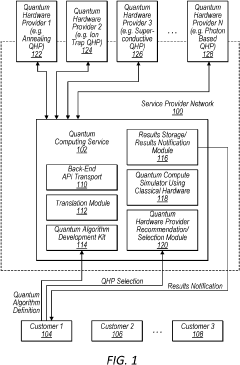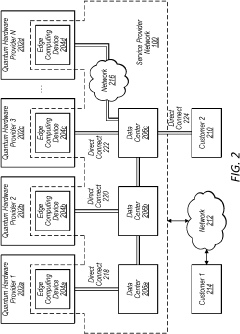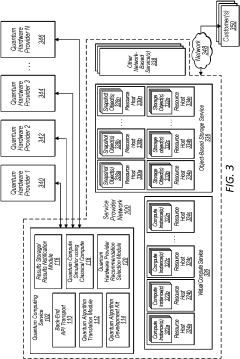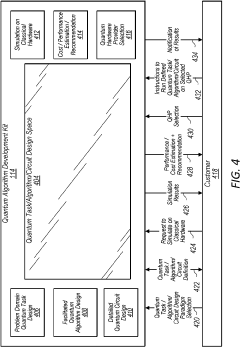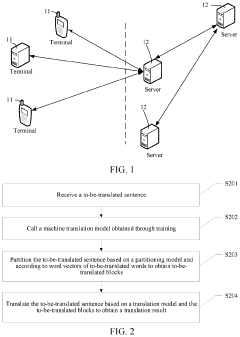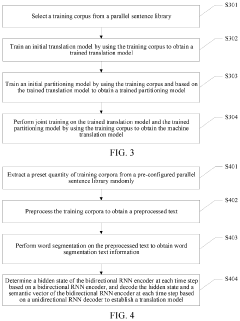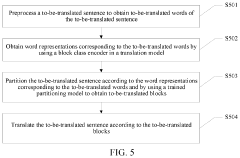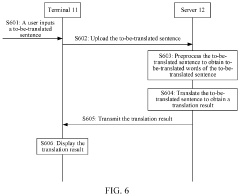Techniques for Quantum Computing-Assisted Machine Translation
JUL 17, 20259 MIN READ
Generate Your Research Report Instantly with AI Agent
Patsnap Eureka helps you evaluate technical feasibility & market potential.
Quantum-NLP Synergy
The convergence of quantum computing and natural language processing (NLP) represents a groundbreaking frontier in the field of machine translation. This synergy holds immense potential to revolutionize the way we approach language barriers and cross-cultural communication. Quantum computing's ability to process vast amounts of data simultaneously and explore multiple linguistic possibilities in parallel aligns perfectly with the complex nature of natural language processing tasks.
At the core of this synergy lies the quantum advantage in handling the inherent ambiguity and contextual nuances of human languages. Traditional machine translation models often struggle with capturing the subtle intricacies of language, leading to inaccurate or unnatural translations. Quantum computing offers a paradigm shift by leveraging quantum superposition and entanglement to represent and process linguistic information in ways that classical computers cannot match.
One of the key areas where quantum-NLP synergy shows promise is in the development of more sophisticated language models. Quantum algorithms can potentially enhance the training and optimization of neural networks used in NLP tasks, leading to more accurate and contextually aware translation systems. This could result in translations that not only convey the literal meaning but also capture the cultural and emotional nuances of the source text.
Moreover, the quantum approach to machine translation opens up new possibilities for handling low-resource languages and improving translation quality for language pairs with limited parallel corpora. Quantum algorithms could potentially extrapolate linguistic patterns and structures more effectively from limited data, addressing one of the major challenges in current machine translation systems.
The integration of quantum computing with NLP also promises advancements in real-time translation capabilities. The quantum speedup could potentially enable instantaneous, high-quality translations for spoken language, breaking down communication barriers in live interactions and global conferences. This could have far-reaching implications for international business, diplomacy, and cultural exchange.
Furthermore, the quantum-NLP synergy extends beyond mere translation to encompass broader aspects of language understanding and generation. Quantum-enhanced natural language processing could lead to more sophisticated chatbots, virtual assistants, and AI-driven content creation tools that can understand and generate human-like text with unprecedented accuracy and naturalness.
As research in this field progresses, we can anticipate the development of hybrid quantum-classical systems that leverage the strengths of both paradigms. These systems could potentially offer practical, scalable solutions for machine translation that combine the quantum advantage in specific computational bottlenecks with the robustness and accessibility of classical NLP techniques.
At the core of this synergy lies the quantum advantage in handling the inherent ambiguity and contextual nuances of human languages. Traditional machine translation models often struggle with capturing the subtle intricacies of language, leading to inaccurate or unnatural translations. Quantum computing offers a paradigm shift by leveraging quantum superposition and entanglement to represent and process linguistic information in ways that classical computers cannot match.
One of the key areas where quantum-NLP synergy shows promise is in the development of more sophisticated language models. Quantum algorithms can potentially enhance the training and optimization of neural networks used in NLP tasks, leading to more accurate and contextually aware translation systems. This could result in translations that not only convey the literal meaning but also capture the cultural and emotional nuances of the source text.
Moreover, the quantum approach to machine translation opens up new possibilities for handling low-resource languages and improving translation quality for language pairs with limited parallel corpora. Quantum algorithms could potentially extrapolate linguistic patterns and structures more effectively from limited data, addressing one of the major challenges in current machine translation systems.
The integration of quantum computing with NLP also promises advancements in real-time translation capabilities. The quantum speedup could potentially enable instantaneous, high-quality translations for spoken language, breaking down communication barriers in live interactions and global conferences. This could have far-reaching implications for international business, diplomacy, and cultural exchange.
Furthermore, the quantum-NLP synergy extends beyond mere translation to encompass broader aspects of language understanding and generation. Quantum-enhanced natural language processing could lead to more sophisticated chatbots, virtual assistants, and AI-driven content creation tools that can understand and generate human-like text with unprecedented accuracy and naturalness.
As research in this field progresses, we can anticipate the development of hybrid quantum-classical systems that leverage the strengths of both paradigms. These systems could potentially offer practical, scalable solutions for machine translation that combine the quantum advantage in specific computational bottlenecks with the robustness and accessibility of classical NLP techniques.
MT Market Landscape
The machine translation (MT) market has experienced significant growth and transformation in recent years, driven by globalization, increased digital content, and advancements in artificial intelligence. The global MT market size was valued at approximately $800 million in 2021 and is projected to reach $1.5 billion by 2026, growing at a CAGR of 13.5% during the forecast period.
The market landscape is characterized by a diverse range of players, including established technology giants, specialized MT companies, and emerging startups. Key market segments include rule-based MT, statistical MT, and neural MT, with the latter gaining substantial traction due to its superior performance in handling complex language pairs and context-aware translations.
Major industry verticals driving the adoption of MT solutions include e-commerce, healthcare, legal, finance, and government sectors. The e-commerce segment, in particular, has seen a surge in demand for real-time translation capabilities to facilitate cross-border transactions and enhance customer experiences in global marketplaces.
Geographically, North America and Europe dominate the MT market, accounting for over 60% of the global market share. However, the Asia-Pacific region is expected to witness the highest growth rate in the coming years, fueled by increasing internet penetration, rising digital content consumption, and the need for multilingual communication in emerging economies.
The competitive landscape is marked by continuous innovation and strategic partnerships. Leading players are investing heavily in research and development to improve translation accuracy, reduce latency, and expand language coverage. Cloud-based MT solutions are gaining popularity due to their scalability and cost-effectiveness, particularly among small and medium-sized enterprises.
Despite the market's growth potential, challenges persist. These include concerns over data privacy and security, the need for domain-specific customization, and the limitations of current MT technologies in handling nuanced or culturally-specific content. Additionally, the integration of MT systems with existing workflows and the requirement for human post-editing to ensure quality remain significant considerations for enterprise adoption.
The emergence of quantum computing-assisted machine translation represents a potential paradigm shift in the MT landscape. While still in its early stages, this technology promises to address some of the fundamental limitations of classical computing approaches, potentially offering unprecedented improvements in translation speed, accuracy, and handling of complex language structures.
The market landscape is characterized by a diverse range of players, including established technology giants, specialized MT companies, and emerging startups. Key market segments include rule-based MT, statistical MT, and neural MT, with the latter gaining substantial traction due to its superior performance in handling complex language pairs and context-aware translations.
Major industry verticals driving the adoption of MT solutions include e-commerce, healthcare, legal, finance, and government sectors. The e-commerce segment, in particular, has seen a surge in demand for real-time translation capabilities to facilitate cross-border transactions and enhance customer experiences in global marketplaces.
Geographically, North America and Europe dominate the MT market, accounting for over 60% of the global market share. However, the Asia-Pacific region is expected to witness the highest growth rate in the coming years, fueled by increasing internet penetration, rising digital content consumption, and the need for multilingual communication in emerging economies.
The competitive landscape is marked by continuous innovation and strategic partnerships. Leading players are investing heavily in research and development to improve translation accuracy, reduce latency, and expand language coverage. Cloud-based MT solutions are gaining popularity due to their scalability and cost-effectiveness, particularly among small and medium-sized enterprises.
Despite the market's growth potential, challenges persist. These include concerns over data privacy and security, the need for domain-specific customization, and the limitations of current MT technologies in handling nuanced or culturally-specific content. Additionally, the integration of MT systems with existing workflows and the requirement for human post-editing to ensure quality remain significant considerations for enterprise adoption.
The emergence of quantum computing-assisted machine translation represents a potential paradigm shift in the MT landscape. While still in its early stages, this technology promises to address some of the fundamental limitations of classical computing approaches, potentially offering unprecedented improvements in translation speed, accuracy, and handling of complex language structures.
QC-MT Challenges
Quantum Computing-Assisted Machine Translation (QC-MT) faces several significant challenges that hinder its widespread adoption and practical implementation. One of the primary obstacles is the current limitations of quantum hardware. Existing quantum computers lack the necessary qubit count and coherence times to handle complex translation tasks effectively. This hardware constraint restricts the scale and complexity of translation models that can be implemented on quantum systems.
Another major challenge lies in the development of quantum algorithms specifically tailored for machine translation. While quantum algorithms have shown promise in certain computational tasks, their application to natural language processing and translation remains in its infancy. Researchers are still exploring ways to leverage quantum superposition and entanglement to enhance translation quality and efficiency.
The integration of classical and quantum systems poses another significant hurdle. Hybrid quantum-classical approaches are being investigated to overcome the limitations of current quantum hardware. However, designing efficient interfaces between quantum and classical components, as well as optimizing the distribution of computational tasks between the two paradigms, remains a complex problem.
Data preparation and encoding for quantum systems present additional challenges. Translating classical text data into quantum states that can be processed by quantum circuits is not straightforward. Developing efficient quantum encoding schemes for linguistic information while preserving semantic relationships is an ongoing area of research.
Error correction and mitigation in quantum systems are crucial for reliable QC-MT implementations. Quantum noise and decoherence can significantly impact the accuracy of translation results. Developing robust error correction techniques and noise-resilient quantum circuits is essential for achieving practical QC-MT systems.
The lack of standardized benchmarks and evaluation metrics specifically designed for QC-MT also poses a challenge. Comparing the performance of quantum-assisted translation models with classical counterparts requires careful consideration of quantum-specific factors and the development of appropriate evaluation frameworks.
Lastly, the scarcity of quantum computing expertise in the natural language processing community presents a barrier to rapid progress in QC-MT. Bridging the knowledge gap between quantum physics, computer science, and linguistics is crucial for advancing the field and developing innovative QC-MT solutions.
Another major challenge lies in the development of quantum algorithms specifically tailored for machine translation. While quantum algorithms have shown promise in certain computational tasks, their application to natural language processing and translation remains in its infancy. Researchers are still exploring ways to leverage quantum superposition and entanglement to enhance translation quality and efficiency.
The integration of classical and quantum systems poses another significant hurdle. Hybrid quantum-classical approaches are being investigated to overcome the limitations of current quantum hardware. However, designing efficient interfaces between quantum and classical components, as well as optimizing the distribution of computational tasks between the two paradigms, remains a complex problem.
Data preparation and encoding for quantum systems present additional challenges. Translating classical text data into quantum states that can be processed by quantum circuits is not straightforward. Developing efficient quantum encoding schemes for linguistic information while preserving semantic relationships is an ongoing area of research.
Error correction and mitigation in quantum systems are crucial for reliable QC-MT implementations. Quantum noise and decoherence can significantly impact the accuracy of translation results. Developing robust error correction techniques and noise-resilient quantum circuits is essential for achieving practical QC-MT systems.
The lack of standardized benchmarks and evaluation metrics specifically designed for QC-MT also poses a challenge. Comparing the performance of quantum-assisted translation models with classical counterparts requires careful consideration of quantum-specific factors and the development of appropriate evaluation frameworks.
Lastly, the scarcity of quantum computing expertise in the natural language processing community presents a barrier to rapid progress in QC-MT. Bridging the knowledge gap between quantum physics, computer science, and linguistics is crucial for advancing the field and developing innovative QC-MT solutions.
Current QC-MT Approaches
01 Quantum-enhanced neural machine translation
Quantum computing techniques are applied to enhance neural machine translation models. This approach leverages quantum algorithms to improve the efficiency and accuracy of translation tasks, potentially outperforming classical machine learning methods in handling complex language structures and semantics.- Quantum-enhanced neural machine translation: Quantum computing techniques are applied to enhance neural machine translation models. This approach leverages quantum algorithms to improve the processing of complex language structures and semantic relationships, potentially leading to more accurate and nuanced translations. The quantum-enhanced models may offer advantages in handling ambiguity and context in language translation tasks.
- Hybrid classical-quantum translation systems: These systems combine classical machine learning algorithms with quantum computing components to optimize translation quality. The hybrid approach allows for the integration of quantum advantages in specific computational bottlenecks while maintaining the robustness of classical methods. This can result in improved translation accuracy and efficiency, especially for challenging language pairs or domain-specific content.
- Quantum-inspired algorithms for language processing: Quantum-inspired algorithms are developed to enhance various aspects of machine translation, such as word alignment, sentence parsing, and language modeling. These algorithms mimic certain quantum behaviors on classical computers, potentially offering improvements in translation quality without the need for actual quantum hardware. This approach can lead to more efficient and accurate language processing techniques.
- Quantum error mitigation in translation systems: Techniques are developed to mitigate errors in quantum-assisted translation systems, addressing the challenges of noise and decoherence in quantum computations. These methods aim to improve the reliability and consistency of quantum-enhanced translations, ensuring that the potential benefits of quantum computing can be effectively realized in practical machine translation applications.
- Quantum-based natural language understanding: Quantum computing techniques are applied to enhance natural language understanding, which is crucial for high-quality machine translation. This approach focuses on improving semantic analysis, context interpretation, and language model training using quantum algorithms. The enhanced understanding of language nuances and contextual meanings can lead to more accurate and contextually appropriate translations.
02 Hybrid quantum-classical translation systems
These systems combine quantum computing capabilities with classical machine translation techniques. The hybrid approach aims to optimize translation quality by utilizing quantum processors for specific computationally intensive tasks while relying on classical algorithms for other aspects of the translation process.Expand Specific Solutions03 Quantum-inspired algorithms for translation
Inspired by quantum principles, these algorithms are designed to run on classical computers but mimic certain quantum behaviors. They aim to improve translation quality by addressing limitations in traditional machine translation methods, such as handling context and ambiguity in language.Expand Specific Solutions04 Quantum natural language processing for translation
This approach applies quantum computing principles to natural language processing tasks specific to machine translation. It focuses on improving the understanding and generation of human language, potentially leading to more accurate and contextually appropriate translations.Expand Specific Solutions05 Quantum error correction in machine translation
Quantum error correction techniques are applied to machine translation systems to enhance the reliability and accuracy of translations. This approach aims to mitigate errors that may arise from quantum noise or decoherence, thereby improving the overall quality and consistency of translations.Expand Specific Solutions
QC-MT Key Players
The quantum computing-assisted machine translation field is in its early developmental stage, with significant potential for growth. The market size is currently limited but expected to expand rapidly as quantum computing technology matures. Major tech companies like Google, IBM, and Alibaba are investing heavily in this area, leveraging their expertise in both quantum computing and AI. Traditional language service providers such as Language Network and Global Tone Communication Technology are also exploring quantum-enhanced translation solutions. The technology is still in the research phase, with academic institutions like MIT and University of Science & Technology of China contributing to advancements. Overall, the field is characterized by high innovation potential but low immediate commercial readiness.
Beijing Baidu Netcom Science & Technology Co., Ltd.
Technical Solution: Baidu's approach to quantum computing-assisted machine translation leverages its expertise in both quantum computing and artificial intelligence. The company is developing quantum algorithms for natural language processing tasks, with a focus on improving the efficiency of neural machine translation models. Baidu's researchers are exploring quantum-inspired tensor network methods for language modeling, which could potentially enhance translation quality by capturing complex linguistic patterns more effectively[7]. They are also investigating quantum approximate optimization algorithms (QAOA) for sequence-to-sequence tasks in translation. Baidu's quantum natural language processing (QNLP) research aims to represent words and sentences as quantum states, allowing for more efficient processing of semantic relationships[8]. The company is working on integrating these quantum techniques with its existing neural machine translation systems to create hybrid quantum-classical models.
Strengths: Strong classical NLP capabilities, growing quantum research team, and access to large-scale language data. Weaknesses: Limited quantum hardware resources compared to some competitors, and practical implementation challenges in integrating quantum techniques with existing systems.
Google LLC
Technical Solution: Google's approach to quantum computing-assisted machine translation leverages its quantum supremacy achievements with the Sycamore processor. The company is exploring hybrid quantum-classical algorithms for natural language processing tasks. Their method combines quantum circuits for certain computationally intensive subtasks with traditional neural networks. Google's quantum approximate optimization algorithm (QAOA) is being adapted for sequence-to-sequence models in translation[1]. They are also investigating quantum-inspired tensor network methods for language modeling, which could potentially enhance translation quality without requiring full-scale quantum hardware[2]. Google's quantum natural language processing (QNLP) research aims to represent words and sentences as quantum states, allowing for more efficient processing of linguistic structures[3].
Strengths: Access to advanced quantum hardware, extensive classical NLP expertise, and significant R&D resources. Weaknesses: Full-scale quantum advantage in NLP not yet demonstrated, and practical implementation challenges remain.
QC-MT Breakthroughs
Quantum computing task translation supporting multiple quantum computing technologies
PatentPendingUS20230325730A1
Innovation
- A quantum computing service that provides access to multiple quantum computing technologies, enabling customers to define and execute quantum tasks, algorithms, or circuits without requiring specific knowledge of the underlying technologies, by selecting the most suitable hardware provider based on factors like cost, error rates, and run-time, and translating quantum objects into formats compatible with different quantum computing technologies for execution.
Machine translation method and apparatus with joint optimization of translation model and partitioning model, electronic device, and storage medium
PatentActiveUS11995415B2
Innovation
- A machine translation method and apparatus that utilize a trained model including a partitioning model and a translation model, where sentences are partitioned into blocks based on word vectors to improve translation accuracy by dividing sentences into smaller, more manageable units for translation.
QC-MT Hardware Reqs
Quantum computing-assisted machine translation (QC-MT) presents unique hardware requirements that differ significantly from classical computing systems. The integration of quantum principles into translation processes necessitates specialized hardware components capable of harnessing quantum mechanical phenomena.
At the core of QC-MT hardware is the quantum processing unit (QPU), which utilizes quantum bits or qubits. Unlike classical bits, qubits can exist in superposition states, allowing for parallel processing of multiple translation possibilities simultaneously. This capability is crucial for handling the complex probabilistic nature of language translation. The QPU must maintain quantum coherence for extended periods to perform meaningful computations, requiring advanced cooling systems and electromagnetic shielding.
Quantum error correction (QEC) is another critical hardware component for QC-MT systems. As quantum states are inherently fragile and susceptible to environmental noise, QEC mechanisms are essential to maintain the integrity of quantum information throughout the translation process. This involves implementing redundant qubits and sophisticated error detection and correction algorithms at the hardware level.
Quantum-classical interfaces form a vital part of QC-MT hardware architecture. These interfaces facilitate the seamless transfer of information between quantum and classical components of the system. They are responsible for preparing input data for quantum processing and measuring the quantum states to extract meaningful translation results.
Memory systems in QC-MT hardware must be designed to accommodate both classical and quantum data. Quantum memory units capable of storing and retrieving quantum states with high fidelity are necessary for intermediate computations and temporary storage of quantum information during the translation process.
The interconnect architecture in QC-MT systems requires specialized design to support the rapid exchange of quantum information between different components. This includes quantum communication channels that preserve quantum coherence and entanglement over distances within the hardware system.
Control systems for QC-MT hardware must be highly precise and responsive to manipulate quantum states accurately. This involves advanced signal generation and processing capabilities to implement quantum gates and measurements with minimal error rates.
Scalability is a crucial consideration in QC-MT hardware design. As translation tasks grow in complexity and volume, the hardware must be capable of scaling up the number of qubits and quantum operations while maintaining performance and reliability.
In summary, QC-MT hardware requirements encompass a range of specialized components and design considerations that enable the exploitation of quantum mechanical principles for machine translation tasks. The successful implementation of these hardware elements is fundamental to realizing the potential advantages of quantum computing in the field of machine translation.
At the core of QC-MT hardware is the quantum processing unit (QPU), which utilizes quantum bits or qubits. Unlike classical bits, qubits can exist in superposition states, allowing for parallel processing of multiple translation possibilities simultaneously. This capability is crucial for handling the complex probabilistic nature of language translation. The QPU must maintain quantum coherence for extended periods to perform meaningful computations, requiring advanced cooling systems and electromagnetic shielding.
Quantum error correction (QEC) is another critical hardware component for QC-MT systems. As quantum states are inherently fragile and susceptible to environmental noise, QEC mechanisms are essential to maintain the integrity of quantum information throughout the translation process. This involves implementing redundant qubits and sophisticated error detection and correction algorithms at the hardware level.
Quantum-classical interfaces form a vital part of QC-MT hardware architecture. These interfaces facilitate the seamless transfer of information between quantum and classical components of the system. They are responsible for preparing input data for quantum processing and measuring the quantum states to extract meaningful translation results.
Memory systems in QC-MT hardware must be designed to accommodate both classical and quantum data. Quantum memory units capable of storing and retrieving quantum states with high fidelity are necessary for intermediate computations and temporary storage of quantum information during the translation process.
The interconnect architecture in QC-MT systems requires specialized design to support the rapid exchange of quantum information between different components. This includes quantum communication channels that preserve quantum coherence and entanglement over distances within the hardware system.
Control systems for QC-MT hardware must be highly precise and responsive to manipulate quantum states accurately. This involves advanced signal generation and processing capabilities to implement quantum gates and measurements with minimal error rates.
Scalability is a crucial consideration in QC-MT hardware design. As translation tasks grow in complexity and volume, the hardware must be capable of scaling up the number of qubits and quantum operations while maintaining performance and reliability.
In summary, QC-MT hardware requirements encompass a range of specialized components and design considerations that enable the exploitation of quantum mechanical principles for machine translation tasks. The successful implementation of these hardware elements is fundamental to realizing the potential advantages of quantum computing in the field of machine translation.
QC-MT Ethics & Privacy
The integration of quantum computing with machine translation raises significant ethical and privacy concerns that must be carefully addressed. As quantum systems process vast amounts of data at unprecedented speeds, there is an increased risk of unauthorized access to sensitive information contained within translation datasets. This includes personal communications, proprietary business documents, and potentially classified government materials. Robust encryption and data protection measures must be developed specifically for quantum-enabled translation systems to safeguard user privacy and prevent data breaches.
Ethical considerations also arise regarding the potential for quantum-assisted machine translation to exacerbate existing language biases or introduce new ones. The immense processing power of quantum computers could amplify subtle biases present in training data, leading to skewed or discriminatory translations. Researchers and developers must implement rigorous testing and bias detection protocols to ensure fair and accurate translations across all languages and cultural contexts.
Another ethical challenge lies in the potential for quantum-enabled translation systems to be used for surveillance or censorship purposes. The ability to rapidly translate and analyze vast amounts of multilingual data could be exploited by authoritarian regimes or malicious actors to monitor communications and suppress free speech. Clear guidelines and regulations must be established to prevent the misuse of this technology and protect individual rights to privacy and freedom of expression.
The environmental impact of quantum computing infrastructure required for large-scale machine translation also raises ethical concerns. The significant energy consumption and resource requirements of quantum systems must be balanced against the potential benefits of improved translation capabilities. Sustainable development practices and energy-efficient quantum technologies should be prioritized to minimize the ecological footprint of quantum-assisted machine translation.
Transparency and accountability in the development and deployment of quantum-enabled translation systems are crucial ethical considerations. Users should be informed about the use of quantum technologies in translation processes and have control over how their data is utilized. Clear mechanisms for addressing errors or biases in translations should be established, along with processes for continuous improvement and ethical oversight of these powerful systems.
Ethical considerations also arise regarding the potential for quantum-assisted machine translation to exacerbate existing language biases or introduce new ones. The immense processing power of quantum computers could amplify subtle biases present in training data, leading to skewed or discriminatory translations. Researchers and developers must implement rigorous testing and bias detection protocols to ensure fair and accurate translations across all languages and cultural contexts.
Another ethical challenge lies in the potential for quantum-enabled translation systems to be used for surveillance or censorship purposes. The ability to rapidly translate and analyze vast amounts of multilingual data could be exploited by authoritarian regimes or malicious actors to monitor communications and suppress free speech. Clear guidelines and regulations must be established to prevent the misuse of this technology and protect individual rights to privacy and freedom of expression.
The environmental impact of quantum computing infrastructure required for large-scale machine translation also raises ethical concerns. The significant energy consumption and resource requirements of quantum systems must be balanced against the potential benefits of improved translation capabilities. Sustainable development practices and energy-efficient quantum technologies should be prioritized to minimize the ecological footprint of quantum-assisted machine translation.
Transparency and accountability in the development and deployment of quantum-enabled translation systems are crucial ethical considerations. Users should be informed about the use of quantum technologies in translation processes and have control over how their data is utilized. Clear mechanisms for addressing errors or biases in translations should be established, along with processes for continuous improvement and ethical oversight of these powerful systems.
Unlock deeper insights with Patsnap Eureka Quick Research — get a full tech report to explore trends and direct your research. Try now!
Generate Your Research Report Instantly with AI Agent
Supercharge your innovation with Patsnap Eureka AI Agent Platform!
